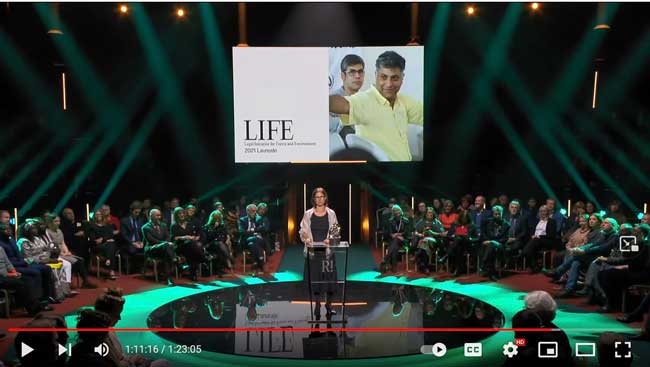
Ritwick Dutta and Rahul Choudhary
Local communities are the first line of defence
YouTube video from 1:14:44 >>
Awarded 2021
Legal Initiative for Forest and Environment (LIFE) is an organisation working to protect the environment in India through the creative use of law and legal processes. LIFE works with communities through a grassroots approach: it assists and empowers often vulnerable populations to stand up against powerful interests and have a voice in the decision-making process, while also strengthening institutions and reforming laws.
Noticing a lack of judicial access regarding environmental issues, LIFE was founded by lawyers Ritwick Dutta and Rahul Choudhary in 2005. Today, the organisation’s attorneys are among India’s leading public interest lawyers. LIFE has helped communities fight against some of India’s most significant environmental threats: the construction of ecologically destructive projects in violation of the law, preventing deforestation and making industrial polluters pay for the damage caused to the environment and public health. […]
India has a robust environmental law framework and an active civil society; however, access to justice for those intending to protect India’s remaining forests and biodiversity is often limited. The high cost of litigation and the long time required combined with the technical nature of the subject matter have made it difficult for people to bring even blatant cases of violation before the courts. […]
Source: Right Livelihood Awards 2021
URL: https://rightlivelihood.org/the-change-makers/find-a-laureate/legal-initiative-for-forest-and-environment-life/
Date Visited: 3 December 2021
Many indigenous peoples, local communities and governments seek intellectual property (IP) protection for traditional knowledge (TK) and traditional cultural expressions (TCEs) as intangible assets. Such assets can range from traditional medicine and environmental knowledge to art, symbols and music.
Genetic resources (GRs) as such are not patentable but inventions based on them may be. Widespread use and the digital and technological transformation of GRs for innovation in the life sciences creates the need for a unique, cross-cutting approach to the interface between IP and GRs.
Source: “Genetic Resources, Traditional Knowledge and Traditional Cultural Expressions”, World Intellectual Property Organization
URL: https://www.wipo.int/tk/en/
Date Visited: 3 January 2022
“Even though they are responsible for protecting the largest part of the global forest heritage […] a third of indigenous and community lands in 64 countries are under threat due to the lack of land tenure rights.” – Pressenza Rio de Janerio in “Indigenous people are heading to CoP26: ‘There is no solution to the climate crisis, without us‘” (Down To Earth) | Forest dwellers in early India – myths and ecology in historical perspective by Romila Thapar >>
See also
Adverse inclusion | Casteism | Rural poverty
Demographic Status of Scheduled Tribe Population of India (Census figures 2011)
Fact checking | Figures, census and other statistics
Human Rights Commission (posts) | www.nhrc.nic.in (Government of India)
Search tips | Names of tribal communities, regions and states of India
“What is the Forest Rights Act about?” – Campaign for Survival and Dignity
“Who are Scheduled Tribes?” – Government of India (National Commission for Scheduled Tribes, NCST)
“The British established mode of forest governance imposed restrictions on local forest-dwelling communities. In 1860, the Company withdrew all access rights for using the forests (food, fuel, medicine and selling forest products) since the forests and forest-dwelling communities provided refuge to the rebels during the Sepoy Mutiny.” – Bharat Rural Livelihoods Foundation >>
“Tribal population was spread all over India and most of them occupied wild tracts, hilly and forested areas, away from more civilized centers. In 1880 their population was estimated at about seventy million. They had existed for centuries with their own social traditions and beliefs and subsisted on natural resources. They had preserved their near isolation and way of life until the British administration and policies made inroads into their territories.” – Subha Johari in Tribal Dissatisfaction Under Colonial Economy of 19th Century >>
“Tribal communities have proven that they are the best guardians of the forest and die-hard conservationists”: Illegal mining destroys the life and culture of the conservators of forests >>
“Even though they are responsible for protecting the largest part of the global forest heritage […] a third of indigenous and community lands in 64 countries are under threat due to the lack of land tenure rights.” – Pressenza Rio de Janerio in “Indigenous people are heading to CoP26: ‘There is no solution to the climate crisis, without us’” (Down To Earth, 1 November 2021) >>

“Two main streams within Indian anthropology influenced the literary and visual representations of tribes by mainstream writers, artists and film-makers.” – Dr. Ivy Hansdak clarifies how they are associated with “assimilationist” and “isolationist” positions or policies >>
In Marginalised but not Defeated, Tarun Kanti Bose (a seasoned public interest journalist) “documents the hard and difficult struggle to implement the Forest Rights Act, how the oppressed adivasis have united into forest unions, how they are now entering into new thresholds of protracted struggles and victories in a non-violent manner.” | Learn more: https://countercurrents.org/2023/05/book-review-marginalised-but-not-defeated >>
“Tribal men and women mix freely, but with respect for each other [but] caste Hindu society in India is so convinced of its own superiority that it never stops to consider the nature of social organisation among tribal people. In fact it is one of the signs of the ‘educated’ barbarian of today that he cannot appreciate the qualities of people in any way different from himself – in looks or clothes, customs or rituals.” – Guest Column in India Today >>
Learn more about colonial policies, the Forest Rights Act, its importance for ecology, biodiversity, ethnobotany and nutrition, and about the usage of Adivasi (Adibasi) communities in different states of India: in legal and historical records, in textbooks, scholarly papers and the media >>
Video | “We need to learn from tribals”: Vandana Shiva on reviving indigenous knowledge at the “Grandmother’s University” Dehradun >>